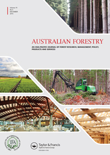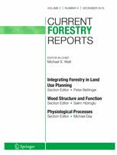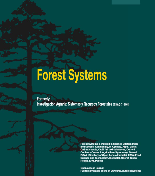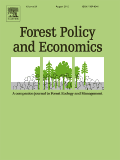
Trees Forests and People
Scope & Guideline
Innovating Solutions for Forest Conservation and Community Engagement
Introduction
Aims and Scopes
- Sustainable Forest Management:
Research on practices that promote the sustainability of forest resources while balancing ecological health, economic viability, and social equity. - Biodiversity Conservation:
Studies aimed at understanding and preserving forest biodiversity, including the impacts of human activities and climate change on various species and ecosystems. - Socio-Ecological Dynamics:
Exploration of the interactions between human communities and forest ecosystems, focusing on livelihoods, cultural practices, and community engagement in forest management. - Climate Change Adaptation:
Research on the impacts of climate change on forest ecosystems and strategies for adaptation, including carbon sequestration and resilience-building measures. - Agroforestry and Land Use Change:
Studies on the integration of trees within agricultural systems, examining their role in enhancing food security, soil health, and ecosystem services. - Forest Economics and Policy:
Analysis of the economic aspects of forestry, including valuation of ecosystem services, market dynamics, and policy implications for sustainable forest management.
Trending and Emerging
- Integrating Local Knowledge and Practices:
Emerging research highlights the importance of incorporating local ecological knowledge into forest management and conservation practices, recognizing the value of indigenous and community perspectives. - Climate Resilience and Adaptation Strategies:
A significant trend is the focus on developing adaptive strategies for forest ecosystems in response to climate change, including resilience-building measures and restoration projects. - Urban Forestry and Green Infrastructure:
Research on the role of urban forests in enhancing ecosystem services and human well-being is gaining traction, reflecting a growing interest in urban ecology and sustainable city planning. - Non-Timber Forest Products (NTFPs):
The exploration of NTFPs as vital components of forest ecosystems and important economic resources for local communities is increasingly prominent, emphasizing their role in sustainable livelihoods. - Technological Innovations in Forestry:
The application of advanced technologies such as remote sensing, machine learning, and GIS in forest management and research is becoming a key area of focus, facilitating data-driven decision-making. - Social Equity in Forest Management:
There is a rising emphasis on social justice and equity in forest management, examining how policies and practices affect different communities and ensuring inclusive participation.
Declining or Waning
- Traditional Forest Management Practices:
There is a noticeable decline in research focused solely on traditional practices, as the emphasis shifts towards integrating modern techniques and community-based approaches. - Single-Species Forestry:
The focus on monoculture forestry systems is diminishing, with a growing recognition of the importance of biodiversity and mixed-species management for ecological resilience. - Static Ecosystem Studies:
Research that does not consider dynamic ecological interactions and changes over time is becoming less prevalent, as the field increasingly values longitudinal studies and adaptive management approaches. - Historical Ecology:
The examination of historical forest conditions and practices is receiving less attention compared to contemporary issues such as climate change and socio-economic impacts on forest ecosystems. - Forest Fire Management Based on Historical Data:
Research that relies primarily on historical data for fire management strategies is waning as real-time data and predictive modeling gain importance in contemporary forest fire management.
Similar Journals

Revista Cubana de Ciencias Forestales
Fostering sustainable solutions for Cuba's forests and beyond.Revista Cubana de Ciencias Forestales, published by UNIV PINAR RIO HERMANOS SAIZ MONTES OCA, is a vital resource in the field of forestry and environmental sciences. Since its inception in 2013, this Open Access journal has dedicated itself to disseminating high-quality research and innovations pertinent to forest ecology, sustainable management, and conservation strategies within the Cuban context and beyond. The journal aims to foster academic dialogue among researchers, professionals, and students by providing a platform for the sharing of interdisciplinary studies that address contemporary challenges in forestry. With its commitment to accessibility, Revista Cubana de Ciencias Forestales ensures that knowledge is available to a global audience, thereby contributing to the advancement of forest sciences and ecological awareness.

Sumarski List
Advancing Forestry Knowledge for a Sustainable FutureSumarski List, published by the Croatian Forestry Society, serves as a key platform for the dissemination of knowledge and research within the field of forestry. Established in the early 1980s, this journal has maintained a consistent commitment to advancing the understanding of forest management, ecology, and conservation. With an ISSN of 0373-1332 and an E-ISSN of 1846-9140, it provides researchers and practitioners with valuable insights into current trends and practices in forestry, although it currently falls within the Q4 category in the 2023 forestry rankings. The journal is accessible primarily in printed format, promoting rigorous scholarship and discussion. The important contributions of Sumarski List are vital for fostering a greater appreciation of forestry in Croatia and beyond, making it an essential resource for those dedicated to tackling the pressing challenges in forest ecosystems.

AUSTRALIAN FORESTRY
Innovating Forestry Practices for TomorrowAustralian Forestry is an esteemed journal dedicated to advancing knowledge in the field of forestry and related environmental science. Published by Taylor & Francis Australia, this journal plays a pivotal role in disseminating high-quality research that spans various aspects of forestry, including sustainable management, conservation practices, and policy analysis. With an impact factor reflecting its significance in the academic community and a Scopus rank of #44 out of 174 in the category of Agricultural and Biological Sciences, Australian Forestry proudly holds a Q2 ranking in its field as of 2023. The journal has maintained a continuous publication record since its inception in 1936, with a commitment to addressing contemporary challenges within forestry. Researchers, professionals, and students alike are invited to engage with this vital resource that fosters insightful dialogue, innovative solutions, and a deeper understanding of forestry science.

Current Forestry Reports
Navigating the future of forestry with groundbreaking findings.Current Forestry Reports, published by Springer International Publishing AG, stands at the forefront of forestry and ecological research, boasting an impressive array of quartile rankings in 2023 such as Q1 in Ecology and Forestry. With an ISSN of 2198-6436, this journal has emerged as a pivotal platform for disseminating innovative research findings and insights critical to the sustainable management of forest ecosystems. Operating out of Switzerland, it covers a broad scope that spans from ecological theory to practical forestry applications and landscape conservation. Notably, it ranks #3 out of 174 in Agricultural and Biological Sciences: Forestry and #4 out of 211 in Environmental Science: Nature and Landscape Conservation, reflecting its high impact and relevance in the field, placing it in the top percentiles in multiple categories. This open-access journal endeavors to provide a comprehensive understanding of contemporary issues, trends, and methodologies in forestry and related disciplines, making it an indispensable resource for researchers, practitioners, and students who are dedicated to advancing knowledge and practices in forest science.

Forest Systems
Advancing ecological knowledge for sustainable forest futures.Forest Systems, an esteemed open-access journal published by CONSEJO SUPERIOR INVESTIGACIONES CIENTIFICAS-CSIC in Spain, has been a dedicated platform for advancing knowledge in the fields of ecology, forestry, and soil science since its inception in 1991. With an ISSN of 2171-5068 and E-ISSN 2171-9845, the journal is committed to disseminating high-quality research that addresses critical issues related to forest ecosystems and their management. Forest Systems is positioned within the Q4 category in Ecology, Evolution, Behavior and Systematics, and Q3 in both Forestry and Soil Science, evidencing its growing influence and relevance in these disciplines. Researchers will find a rich repository of articles that not only contribute significantly to academic discourse but also foster practical solutions to contemporary environmental challenges. As it converges from 2010 to 2024, the journal aims to enhance its outreach and impact, facilitating access for professionals, students, and policymakers committed to sustainable forest management and ecological conservation.

Austrian Journal of Forest Science
Connecting academia and practice in forestry science.Austrian Journal of Forest Science, published by OSTERREICHISCHER AGRARVERLAG, is a distinguished peer-reviewed journal dedicated to advancing knowledge in the fields of forestry and ecological science. With an ISSN of 0379-5292 and an E-ISSN of 0375-524X, this journal serves as a vital platform for researchers, professionals, and students alike, aiming to disseminate innovative research findings, methodologies, and case studies pertinent to forest conservation, management, and policy. Situated in Austria, its diverse scope encompasses critical topics within ecology, evolution, and biodiversity, evidenced by its competitive quartile rankings in 2023, placing it in Q2 for Forestry and Q3 in other related fields. The journal is committed to fostering a deeper understanding of forest ecosystems, making it an essential resource for anyone invested in sustainable forestry practices and environmental policy.

Forest Policy and Economics
Advancing sustainable solutions for forest management.Forest Policy and Economics is a leading international journal published by ELSEVIER, dedicated to advancing the field of forest management and economics. With an impact factor indicative of its relevance, this journal holds prestigious Q1 rankings across multiple categories, including Economics and Econometrics, Forestry, Management, Monitoring, Policy and Law, as well as Sociology and Political Science. Given its robust Scopus rankings, it places within the top tiers of its fields, making it an essential resource for researchers, professionals, and students alike. Since its inception in 2000, the journal has provided a platform for innovative research and comprehensive reviews addressing critical issues in forest policy and economics until 2024. The journal fosters scholarly discussion on sustainable practices, policy design, and economic frameworks essential for effective forest management in the context of global environmental challenges. As a crucial source of knowledge, Forest Policy and Economics is invaluable for those striving to influence policy and practice within the forestry sector.

JOURNAL OF TROPICAL FOREST SCIENCE
Exploring the Depths of Tropical ForestryThe JOURNAL OF TROPICAL FOREST SCIENCE, published by the FOREST RESEARCH INST MALAYSIA, serves as a vital platform for disseminating research focused on tropical forestry. Since its inception in 1988 and transitioning to its current form in 1993, this journal has established itself within the academic community, currently holding a commendable Q3 ranking in the Forestry category, as per the 2023 metrics. With an ISSN of 0128-1283 and E-ISSN 2521-9847, it provides crucial insights into the ecological, economic, and social aspects of tropical forest management and conservation, making it an indispensable resource for researchers, practitioners, and students alike. Although it does not operate under an open-access model, the journal emphasizes quality and relevance in its publications, contributing significantly to the ongoing discourse in agricultural and biological sciences with a Scopus rank of #89 out of 174 and a 49th percentile position.

NEW FORESTS
Leading the Charge in Forestry Research.NEW FORESTS, published by SPRINGER, stands at the forefront of forestry research, delivering cutting-edge insights into forest science, management, and conservation. With an ISSN of 0169-4286 and an E-ISSN of 1573-5095, this esteemed journal has earned a distinguished reputation as it continues to contribute significantly to the field since its inception in 1986. As evidenced by its impressive ranking in the Q1 category for Forestry and being positioned at #32/174 in the Scopus Ranks for Agricultural and Biological Sciences, NEW FORESTS maintains an 81st percentile standing, emphasizing its influential role in advancing scientific discourse. The journal focuses on a diverse array of topics within the realm of forestry, making it an essential resource for researchers, professionals, and students eager to engage with contemporary developments and challenges in forest ecosystems. Although it is not an open-access journal, access to its articles can be facilitated through various academic institutions and libraries, ensuring that vital research is available to a broad audience. As we look toward the future, NEW FORESTS continues to strive for excellence, fostering dialogue and collaboration among scholars committed to sustainable forest management and restoration until at least 2024.

Forestist
Exploring the future of forest management and conservation.Forestist, published by AVES, is a pivotal open-access journal dedicated to the field of Forestry, providing a platform for researchers, professionals, and students to explore cutting-edge developments and research within the discipline since 1980. Operating from Turkey, this journal offers a unique opportunity for scholars to share their findings with a broad audience, contributing to the global discourse on sustainable forest management, conservation practices, and ecological research. With an impressive impact factor and a current categorization in the Q3 quartile for 2023, Forestist ranks among the essential resources in Agricultural and Biological Sciences, particularly within the realm of Forestry, as indicated by its Scopus ranking of #119 out of 174 journals. This publication is committed to fostering open access to knowledge, making research freely available while encouraging innovative studies that address the pressing challenges in forestry and environmental science.